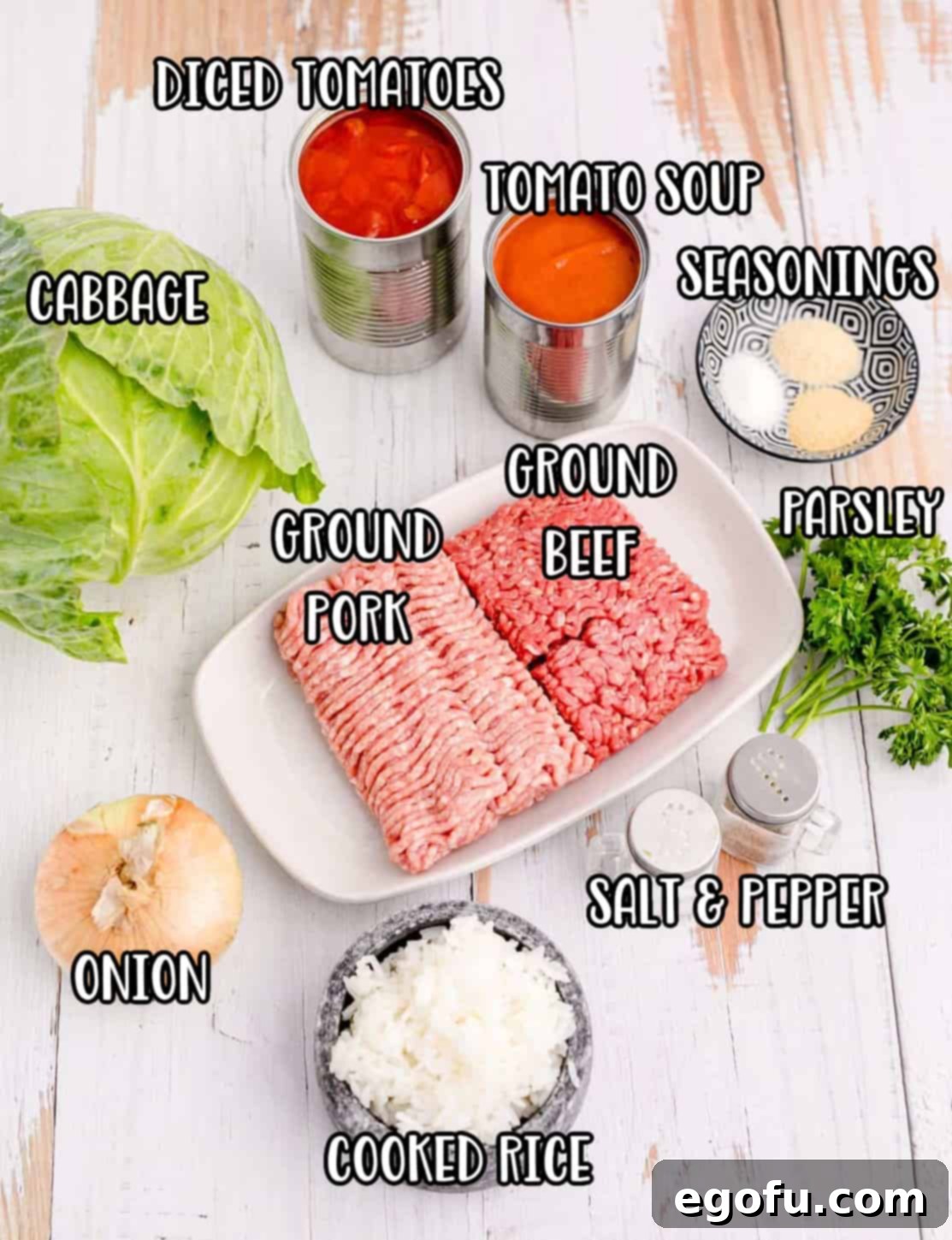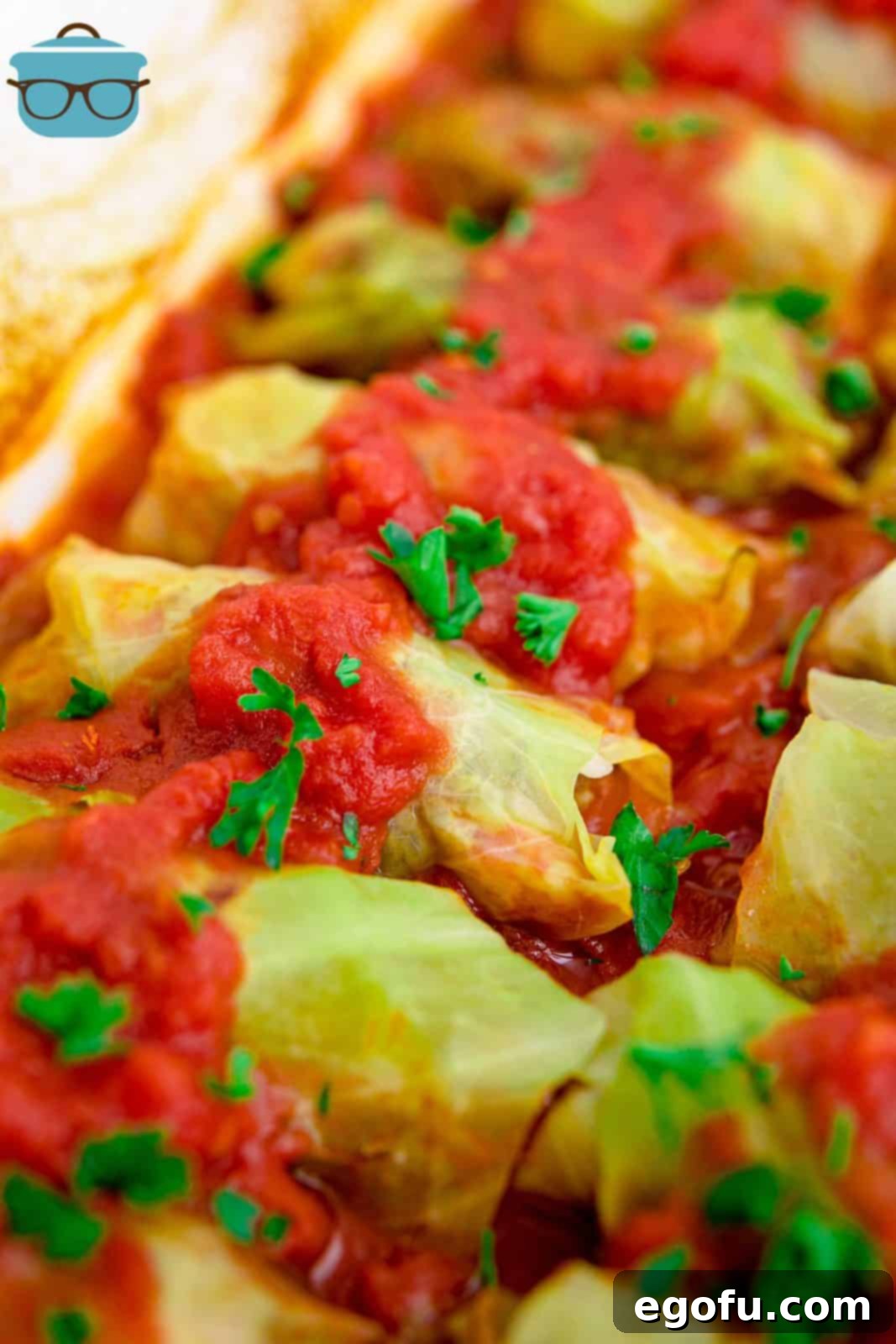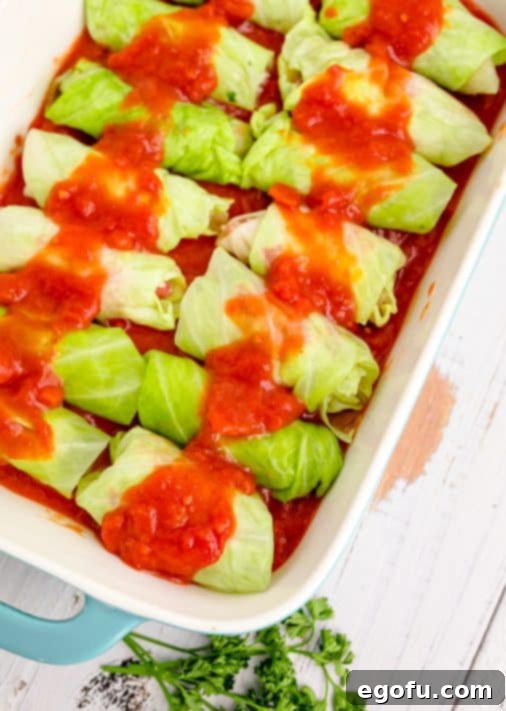Savor the rich, comforting flavors of a true classic with these Homemade Stuffed Cabbage Rolls. This beloved recipe transforms humble ingredients into a hearty, satisfying meal that families have cherished for generations. Whether you’re new to making cabbage rolls or revisiting a nostalgic favorite, this easy-to-follow guide ensures a delicious outcome that will have everyone reaching for more!
Classic Stuffed Cabbage Rolls: A Hearty & Flavorful Homemade Recipe
Stuffed Cabbage Rolls, known by various names across cultures like Golabki, Halupki, or Sarma, represent the epitome of comfort food. This timeless dish brings warmth and satisfaction to any dinner table, blending tender cabbage leaves with a seasoned, savory meat and rice filling, all bathed in a rich, tomato-based sauce. For many, it’s more than just a meal; it’s a culinary journey back to cherished family gatherings and treasured memories.
What makes this particular recipe so special is its approachability. While traditional cabbage rolls might seem daunting, our method streamlines the preparation without sacrificing any of the authentic flavor. The magic truly happens during the baking process, as the flavors meld together, and the cabbage softens beautifully, losing its raw edge and absorbing the delicious essence of the filling and sauce. Even those who claim not to be fans of cabbage often find themselves pleasantly surprised, finding this dish irresistible.
Each bite offers a perfect harmony: the tender, slightly sweet cabbage, the robust and perfectly spiced meat and rice mixture, and the tangy-sweet tomato sauce that ties it all together. It’s a filling and hearty dinner that promises to satisfy even the biggest appetites, making it a perfect choice for family dinners, holiday meals, or simply a cozy night in.

Frequently Asked Questions About Homemade Cabbage Rolls
Adding a small amount of sugar to tomato-based sauces is a common culinary trick. Its purpose is to balance the natural acidity of the tomatoes, creating a more mellow and well-rounded flavor profile. Without it, the sauce can sometimes taste too sharp or tart. Many well-regarded tomato sauce recipes incorporate a touch of sugar for this very reason, enhancing the overall deliciousness of the dish.
Absolutely! While microwaving is a quick and convenient method, you can certainly prepare the cabbage leaves using traditional boiling. One approach is to submerge the entire cored cabbage head in a large pot of boiling salted water. Cook until the outer leaves are tender enough to be gently peeled away without tearing. As leaves soften, remove them, then continue cooking the remaining head to loosen more leaves. Alternatively, you can remove the leaves first and then boil them individually in salted water for about 3 minutes each until pliable.
Since stuffed cabbage rolls are a hearty and filling meal on their own, it’s often best to choose simple, complementary sides. Steamed or roasted green vegetables like broccoli or green beans add a fresh contrast. Corn on the cob or a light, crisp garden salad are also excellent choices. For a more substantial pairing, egg noodles or German spaetzle complement the flavors beautifully, allowing the rolls to remain the star of the plate. A slice of warm garlic bread is always a welcome addition too!
Yes, absolutely! While the combination of ground beef and pork adds a wonderful depth of flavor and texture, these cabbage rolls will still be incredibly delicious if you choose to use only ground beef. Simply use 1 pound of ground beef and keep all other ingredients and instructions the same. For the best results and to prevent excess grease, we recommend using a leaner ground beef (e.g., 90/10 or 93/7 fat content).
Yes, make-ahead preparation is one of the fantastic benefits of this recipe! You can assemble the cabbage rolls, place them in your baking pan, and cover them with the tomato sauce. Then, tightly cover the pan and refrigerate for up to one day before baking. For longer storage, you can freeze them unbaked for up to a month. Just ensure they are properly wrapped to prevent freezer burn. When ready to bake from frozen, simply thaw overnight in the refrigerator before following the baking instructions.
Yes, the meat filling in cabbage rolls is typically raw when assembled. The prolonged baking time in the oven, combined with being enveloped by the cabbage leaves and sauce, ensures that the meat cooks thoroughly and safely. This slow cooking process also allows the meat to absorb all the wonderful flavors from the seasonings and sauce, resulting in a tender and incredibly flavorful filling.
The primary reason to remove the hard, thick center ridge from each cabbage leaf is to make them much easier to roll. This rigid part can be quite stiff and difficult to bend, making the rolling process cumbersome. By slicing along the ridge, you essentially create two smaller, more manageable, and flexible leaf halves. This not only simplifies rolling but also results in a more tender and pleasant eating experience, as you avoid biting into a tough, fibrous core.
Absolutely! The slow cooker is a fantastic alternative for making tender, flavorful cabbage rolls with minimal effort. While this recipe is designed for oven baking, you can adapt it for your crock pot. In fact, we have a dedicated recipe for Crock Pot Cabbage Rolls that offers specific instructions and tips for achieving perfect results in your slow cooker.
Yes, cooked cabbage rolls freeze exceptionally well, making them an ideal meal prep option. To freeze leftovers or a prepared batch, allow them to cool completely. Then, transfer them to a freezer-safe airtight container. They will maintain their quality for up to 1 month. When you’re ready to enjoy them, simply thaw them overnight in the refrigerator and then reheat gently in the oven or microwave until warmed through. For fresh leftovers you plan to consume within a few days, an airtight container in the refrigerator will keep them delicious for 3-4 days.

Essential Ingredients for Perfect Cabbage Rolls
Crafting delicious stuffed cabbage rolls starts with a selection of fresh, high-quality ingredients. Here’s a closer look at what you’ll need and why each component is vital for creating this comforting classic:
- Cooked White Rice: This recipe is an excellent way to utilize leftover rice, ensuring no waste and speeding up prep time. White rice provides a tender, absorbent base for the filling, soaking up all the savory juices. Feel free to experiment with brown rice or even cauliflower rice if you prefer a different texture or nutritional profile; just ensure it’s cooked before mixing.
- Cabbage: The star of the show! Look for a large, firm head of green cabbage with vibrant, unblemished leaves. Avoid any heads with soft spots or brown edges, as these indicate older cabbage that may be difficult to work with. A fresh, crisp head will yield the most pliable leaves for rolling.
- Ground Beef and Ground Pork: We love using a combination of both ground beef and ground pork. This blend offers a richer, more complex flavor profile and a wonderfully juicy texture that’s hard to beat. The pork adds a subtle sweetness and extra moisture, while the beef provides that classic hearty foundation. However, if you have a preference or dietary restriction, using all ground beef (ideally a leaner cut like 90/10) or all ground pork will still yield delicious results. Using lower-fat meat helps prevent the final dish from being overly greasy.
- Onion: A finely diced sweet yellow onion, such as a Vidalia, is our go-to choice. It introduces a foundational sweetness and aromatic depth to the filling. Alternatively, a shallot could be used for a slightly milder, more refined onion flavor with a hint of garlic.
- Seasonings (Salt, Pepper, Garlic Powder, Onion Powder): These fundamental seasonings are crucial for building the flavor base of your meat and rice filling. They enhance the natural taste of the ingredients and create that irresistible savory aroma. Don’t hesitate to adjust the quantities to suit your personal taste preferences, perhaps adding a pinch of paprika for color or a dash of cayenne for a subtle kick.
- Tomato Soup: This might seem unconventional, but canned tomato soup is a secret weapon in many classic cabbage roll recipes. It contributes a creamy consistency and a subtly spiced, richer flavor to the sauce compared to plain tomato sauce, as it often contains additional seasonings. It helps create a velvety coating for the rolls.
- Diced or Crushed Tomatoes: To complement the tomato soup, either diced or crushed tomatoes provide a robust, fresh tomato flavor and texture to the sauce. Diced tomatoes offer small chunks for those who enjoy them, while crushed tomatoes create a smoother sauce. Choose based on your textural preference.
- Sugar: As discussed in our FAQs, a small amount of sugar is essential for balancing the acidity of the tomatoes in the sauce. It rounds out the flavors beautifully, ensuring the sauce is savory with just a hint of sweetness rather than overly tart.

How to Make Flavorful Stuffed Cabbage Rolls: A Step-by-Step Guide
Follow these detailed steps to create perfectly tender and delicious stuffed cabbage rolls from scratch. The process is straightforward and yields incredibly satisfying results.
Preparing the Cabbage Leaves
The first crucial step is preparing the cabbage leaves so they are pliable enough for rolling. This method uses the microwave for quick and efficient softening.
- Begin by lightly spraying a 9×13-inch baking pan with cooking spray to prevent sticking. Preheat your oven to 350°F (175°C), ensuring it’s ready when your rolls are assembled.
- Take your large head of cabbage and use a long, thin knife to carefully remove its core. This makes it easier for the heat to penetrate and loosen the leaves.
- Place the cored cabbage head into a large, microwave-safe dish with a lid. Pour about ½ cup of water into the dish, then cover it tightly. Microwave on high power for 5 minutes. This initial burst of heat begins the softening process.
- Carefully remove the dish, turn the cabbage head over, re-cover, and microwave for another 10 minutes. This ensures even softening of the leaves.
- Once cooked, carefully drain all the water from the cabbage bowl. Allow the cabbage to cool completely until it’s comfortable enough to handle. This cooling step is important to prevent burning your hands while peeling the leaves.

Crafting the Delicious Filling and Sauce
While your cabbage cools, you can prepare the savory meat and rice filling and the rich tomato sauce.
- Once the cabbage is cool enough, begin to gently peel the softened leaves off one at a time. Lay them flat on a clean kitchen towel to dry thoroughly and cool further. This step ensures the leaves aren’t overly wet when you start rolling.
- For the filling, in a large mixing bowl, combine the cooked white rice, ground beef, ground pork, finely chopped onion, optional freshly chopped parsley, salt, garlic powder, onion powder, and black pepper. Use your hands to thoroughly mix all the ingredients until they are well combined. Set this flavorful mixture aside.
- In a separate bowl, prepare your rich tomato sauce. Whisk together the canned tomato soup, diced or crushed tomatoes, and sugar until smooth and well integrated. This sauce will envelop your cabbage rolls, infusing them with incredible flavor. Set this aside as well.

Rolling and Assembling the Cabbage Rolls
This is where your cabbage leaves transform into neat, flavorful parcels.
- Before rolling, gently pat the cabbage leaves dry with paper towels. Then, using a knife, carefully remove the hard, thick ridge that runs down the center of each leaf. This will effectively create two separate, more flexible pieces from each larger leaf. This step is crucial for easy rolling and results in a more pleasant eating experience, as the tough ridge is removed.
- Take one prepared cabbage leaf (or half leaf) and place approximately 1 ½ to 2 tablespoons of the meat and rice filling onto the wider end, near the base of the leaf.
- To roll, first fold the bottom edge of the leaf over the filling. Then, fold in the sides of the leaf. Finally, tightly roll the leaf upwards from the bottom to create a compact, secure parcel. Continue this process until all the filling and cabbage leaves are used.

Baking to Perfection
The final stage brings all the flavors together in the oven.
- Pour half of the prepared tomato sauce mixture into the base of your greased 9×13-inch baking dish, spreading it evenly. This layer will prevent the rolls from sticking and infuse flavor from the bottom.
- Carefully arrange the assembled cabbage rolls seam-side down in the baking dish. Place them in two long, snug rows, ensuring they fit tightly together. If your baking dish is smaller and requires layering, make sure to spread some tomato sauce over each layer of rolls to keep them moist and flavorful.
- Once all the rolls are in place, pour the remaining tomato sauce evenly over the top of all the cabbage rolls, ensuring they are well coated.

- Cover the baking pan tightly with aluminum foil. This traps steam and ensures the cabbage rolls cook through and become incredibly tender. Bake in the preheated oven for 90 minutes.

- Once baked, remove the pan from the oven and allow it to cool for about 10 minutes before serving. This resting period allows the flavors to further meld and makes the rolls easier to handle and serve without falling apart.

Tips for the Best Cabbage Rolls Every Time
Achieving perfectly tender and flavorful cabbage rolls is simple with a few expert tips:
- Choose the Right Cabbage: A large, fresh head of green cabbage with intact, flexible outer leaves is key. Avoid any with bruises or tough, brittle leaves.
- Don’t Overfill: While tempting to pack them full, overfilling can make rolls difficult to seal and prone to bursting during baking. Aim for 1.5 to 2 tablespoons of filling per leaf.
- Seal Properly: Ensure the ends are tucked in and the seam is placed face down in the baking dish. This keeps the filling secure and prevents unraveling.
- Allow for Resting Time: Don’t rush to serve immediately after baking. A 10-minute rest allows the rolls to set, the flavors to deepen, and the juices to redistribute, making them easier and more enjoyable to eat.
- Lean Meat is Key: Whether using beef, pork, or a combination, opt for leaner cuts. This minimizes excess grease in your sauce and keeps the dish lighter.
- Taste and Adjust Seasoning: Before rolling, taste a small portion of your raw meat mixture (if comfortable) or cook a tiny spoonful. Adjust salt, pepper, and other seasonings as needed to match your preference.
Creative Cabbage Roll Variations to Explore
While this classic recipe is a family favorite, there are many ways to adapt it to suit different tastes and dietary needs:
- Vegetarian Option: Replace the ground meat with a mix of mushrooms, lentils, finely chopped walnuts, and extra cooked rice or quinoa for a hearty plant-based filling.
- Spicier Kick: Add a pinch of red pepper flakes or a dash of hot sauce to the meat filling or tomato sauce for a touch of heat.
- Different Grains: Instead of white rice, try cooked brown rice, quinoa, or even couscous for varied textures and nutritional benefits.
- Unstuffed Cabbage Roll Casserole: For a deconstructed version, layer chopped cabbage, ground meat mixture, and sauce in a baking dish and bake. It offers all the flavor with less rolling effort!
- Different Sauces: While tomato soup is traditional, you could use a plain marinara sauce, a creamy dill sauce (common in some Eastern European versions), or even a mushroom gravy for a different flavor profile.
- Add Extra Vegetables: Finely grated carrots, bell peppers, or zucchini can be incorporated into the meat filling for added nutrients and flavor.
What to Serve with Your Stuffed Cabbage Rolls
Stuffed cabbage rolls are a complete meal, but they pair wonderfully with simple side dishes that complement their rich flavors. Consider serving them alongside a crisp green salad with a light vinaigrette to cut through the richness. A side of mashed potatoes or creamy polenta is perfect for soaking up the delicious tomato sauce. For a pop of color and extra vegetables, steamed green beans, roasted asparagus, or a simple side of buttered noodles are all excellent choices. A crusty bread is also great for dipping!
Storage & Make-Ahead Tips
Cabbage rolls are fantastic for meal planning and make-ahead convenience. Here’s how to store them effectively:
- Refrigeration: Leftover cooked cabbage rolls can be stored in an airtight container in the refrigerator for up to 3-4 days. Reheat gently in the microwave or oven until warmed through.
- Freezing (Unbaked): Assemble the rolls and place them in your baking dish, covered with sauce, as instructed. Tightly cover the entire dish with plastic wrap and then aluminum foil. Freeze for up to 1 month. When ready to bake, thaw the rolls in the refrigerator overnight, then bake as directed.
- Freezing (Baked): Once cooked and cooled completely, transfer the cabbage rolls (with some sauce) to a freezer-safe airtight container or freezer bags. They will keep well for up to 1 month. Thaw overnight in the refrigerator before reheating gently in the oven (covered) or microwave.
Cabbage Rolls Recipe Card

Cabbage Rolls
A classic and flavorful recipe, these Stuffed Cabbage Rolls are a dinner recipe everyone loves and always comes back for seconds!
Prep Time: 30 minutes
Cook Time: 1 hour 30 minutes
Total Time: 2 hours
Servings: 6
Author: Brandie Skibinski
Rating: 5 out of 5 stars (36 Reviews)
Ingredients
- 1 large head cabbage
- ¾ cup cooked white rice
- ½ pound ground beef
- ½ pound ground pork (lean is best)
- 1 small onion, small diced
- 1 Tablespoon freshly chopped parsley (optional)
- 1 teaspoon salt
- ½ teaspoon garlic powder
- ½ teaspoon onion powder
- ½ teaspoon pepper
- 10 ounce can tomato soup
- 15 ounce can diced or crushed tomatoes
- ½ teaspoon sugar
Instructions
- Spray a 9×13-inch baking dish. Preheat the oven to 350F degrees.
- Use a long thin knife to remove the core from the cabbage head.
- Place the cabbage in a covered microwave-safe dish with ½ cup of water. Cook on high power for 5 minutes.
- Turn the cabbage over and cook for another 10 minutes. Drain the water completely and allow it to cool enough to handle.
- Peel the leaves off one at a time and allow them to dry and fully cool on a kitchen towel.
- While the cabbage cools, combine the rice, ground beef, ground pork, chopped onion, parsley, salt, garlic powder, onion powder, and pepper for the filling. Set aside.
- In a separate bowl, mix the tomato soup, diced/crushed tomatoes, and sugar for the sauce. Set aside.
- Pat the cabbage leaves dry. Carefully remove the hard center ridges with a knife, creating two separate pieces from each large leaf. This makes them much easier to roll and eat.

- Take one cabbage leaf (or half leaf) and place about 1 ½ to 2 Tablespoons of filling onto it.

- Roll up the leaf, tucking the ends under to secure the filling. Continue with all remaining leaves.

- Pour half of the tomato mixture into the base of the prepared baking dish.

- Arrange the cabbage rolls seam-side down in two long, snug rows. If layering is necessary due to a smaller dish, ensure each layer is covered with some tomato sauce.
- Pour the rest of the tomato sauce evenly over all the cabbage rolls.

- Cover the pan tightly with aluminum foil and bake for 90 minutes.
- Let cool for about 10 minutes before serving to allow flavors to meld and for easier handling.

Recipe Notes
- For ingredient substitutions or common questions, refer to the FAQ section and ingredient list above for more details.
- If you prefer, you can use 1 pound of lean ground beef instead of the beef and pork mixture.
- Always ensure you are using cooked rice for this recipe. Uncooked rice will not cook properly within the rolls.
- Using lower fat meat (e.g., 90/10 ground beef) helps prevent an excessive amount of grease from releasing into the sauce during cooking.
- The sugar added to the tomato sauce is crucial for balancing its acidity, resulting in a more harmonious and flavorful sauce.
- These cabbage rolls can be frozen, either before or after baking. Please refer to the “Storage & Make-Ahead Tips” section above for detailed instructions.
Course: Main Course, Side Dish
Cuisine: American
Nutrition
Calories: 323kcal | Carbohydrates: 29g | Protein: 17g | Fat: 16g | Sodium: 735mg | Fiber: 6g | Sugar: 13g
Nutritional Disclaimer
“The Country Cook” is not a dietician or nutritionist, and any nutritional information shared is an estimate. If calorie count and other nutritional values are important to you, we recommend running the ingredients through whichever online nutritional calculator you prefer. Calories and other nutritional values can vary quite a bit depending on which brands were used.
Explore More Comfort Food Recipes
If you love the comforting appeal of these classic stuffed cabbage rolls, you’re sure to enjoy these other heartwarming recipes. From more cabbage-based delights to other savory, filling dishes, discover your next family favorite:
- Bacon Fried Cabbage
- Cabbage Roll Soup
- Crock Pot Cabbage Rolls
- Crock Pot Unstuffed Cabbage Rolls
- Stuffed Pepper Soup
- Crock Pot Stuffed Peppers
- Cheesesteak Stuffed Peppers
- Homemade Sauerkraut
- Quick Sauerkraut
- Instant Pot Corned Beef (with Irish Slaw)






